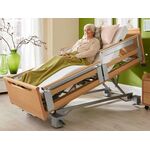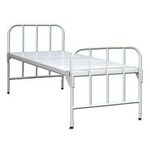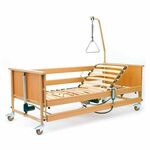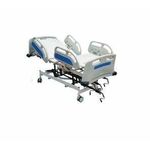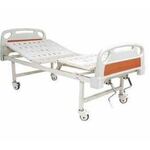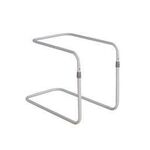What is a hospital bed?
Hospital beds are special furniture designed for the purpose of medical care and treatment of patients in hospitals, clinics, and nursing homes. Such beds are necessary for giving comfort, support, and medical assistance to those patients undergoing surgery or treatment with chronic conditions.
Hospital beds are also known as profiled care beds, and apart from comfort, they provide room for necessary function to ensure functionality appropriate to meet different kinds of care needs.
The following are potential users of a hospital bed:
• Generally, people who require limited mobility or even disability
• People with the need to recover from surgery
• People who possess long-term illnesses
• Palliative care patients.
Key Features of hospital bed:
In hospitals, the most basic features provided with hospital beds are meant to meet the needs of the patient and the care providers as well. These are listed below:
- Adjustable height: Hospital beds have adjustable height. Such a thing will make the entry easy for the patient. Moreover, if the bed is raised, it also helps the carers avoid back strain and injury while executing on-bed care.
- Head and Foot Sections: They come with adjustable head and foot sections so that the patients can easily find a proper sleeping position.
- Side rails: Inpatient bed with side rails will add a safety feature preventing falls from the bed for the at-risk patient. However, they also can be used as a grab rail when transferring to and from the bed depending on the design of the side rails, like our Signature Comfort Plus profiling bed.
- Wheels: Hospital beds come with wheels, allowing for easy maneuverability around the hospital room.
- Mattresses: Hospital beds have mattresses, that are specifically designed for comfort and support to patients.
How does a hospital bed work?
Performing a hospital bed setup with modern advanced devices has become very easy.
After configuring the hospital bed according to the instruction manual, which includes adjusting the height, positioning the patient comfortably, and securing safety features like side rails, the process of preparing the patient bed for use begins with a simple check of the settings.
The procedure includes:
- The caregiver can easily adjust the height and angle of the medical bed to ensure optimal comfort and accessibility for both the patient and healthcare providers.
- Ensuring that the side rails are secure helps prevent falls, especially for patients in an ICU bed or those requiring additional support.
- If the hospital bed is equipped with monitoring devices, caregivers can continuously track vital signs and comfort levels throughout the patient’s stay.
- The design of the Fowler bed facilitates various patient needs, allowing caregivers to administer medications and perform personal care tasks efficiently.
Healthcare professionals utilize hospital beds to ensure that patients receive the best care possible during their recovery, making them essential for patient well-being in medical settings.
Use or purpose of a Hospital Bed:
Unlike standard hospital beds, which provide static support for patients, advanced medical beds offer features that allow for continuous monitoring of a patient’s condition over time. These beds can be equipped with integrated monitoring systems that track vital signs and patient movements, providing essential insights into patient health during daily activities, thereby aiding in effective treatment planning.
Healthcare providers may recommend specific types of hospital beds for their patients in the following cases:
- Adjustable hospital beds can be modified to enhance patient comfort, allowing caregivers to monitor how different positions affect the patient’s overall health.
- For patients with known conditions such as respiratory issues or mobility challenges, these medical beds can facilitate ongoing assessment and adjustments based on their condition.
- Beds such as Fowler beds are particularly useful for patients recovering from surgery, as they help maintain optimal positioning to monitor heart function and other vital signs.
By using advanced hospital beds, healthcare professionals can ensure that patients receive tailored care, enhancing their recovery and overall well-being.
Different types of Hospital Bed:
Standard Hospital Beds:
- Standard hospital beds are typically made of metal or plastic and consist of a bed frame, a headrest, and a footrest.
- They may be raised or lowered to various heights and feature movable side railings. The bed is usually mounted on wheels to enable easy movement around the hospital, but in many cases, these are fixed as well.
Common uses: Standard hospital beds are used for patients who require basic medical care and do not need specialized features.
They are commonly used in medical-surgical units, general wards, and emergency departments.
Low Hospital Beds:
- Low hospital beds, also known as floor-level beds, are designed to be closer to the ground than standard hospital beds.
- Low hospital beds have a similar design to standard hospital beds, but are closer to the ground. They are set on wheels for simple mobility and contain a bed frame, headrest, and footrest.
- They also have adjustable side rails that can be raised or lowered to provide additional support and prevent patients from falling.
Common uses: Low hospital beds are typically used for patients who are at a higher risk of falls, such as elderly patients, or patients with limited mobility, such as those with spinal cord injuries or recovering from joint replacement surgery.
Bariatric Hospital Beds:
- Bariatric hospital beds are designed for patients who are overweight or obese and require a higher weight capacity than standard hospital beds can provide.
- Standard hospital beds are narrower and less sturdy than bariatric hospital beds, which can support more weight.
- They are typically made of heavy-duty materials, such as reinforced steel, and have a wider bed frame and a larger sleeping surface.
Common uses: Bariatric hospital beds are typically used for patients who are overweight or obese and require specialized medical care, such as those recovering from bariatric surgery or undergoing treatment for obesity-related medical conditions.
ICU Hospital Beds:
- ICU (Intensive Care Unit) hospital beds are specialized hospital beds designed for critically ill patients who require close monitoring and intensive medical care.
- ICU hospital beds are made to offer life-saving treatment to patients who need constant supervision and assistance.
- They are equipped with specialized medical technology and features that allow healthcare providers to deliver continuous care and treatment to critically ill patients.
Common uses: ICU hospital beds are typically used for critically ill patients who require close monitoring and intensive medical care, such as those with severe infections, respiratory failure, or organ failure.
Pediatric Hospital Beds:
- Pediatric hospital beds are smaller and more lightweight than adult hospital beds, with a focus on providing a comfortable and safe environment for children.
- They are typically designed with bright colors and fun designs to make the hospital environment less intimidating for children.
Common uses: Pediatric hospital beds are typically used for children who require medical care, such as those recovering from surgery, illness, or injury.
Specialty Hospital Beds:
- Specialty hospital beds are hospital beds designed for patients with unique medical needs or conditions that require specialized care.
- These beds are designed to provide optimal patient care and comfort for specific medical conditions.
- Specialty hospital beds are designed to provide specialized care for patients with unique medical needs or conditions. They are designed with specific features and technology to optimize patient care and comfort.
Common uses: Specialty hospital beds are used for patients with unique medical needs or conditions, such as those with pressure ulcers, spinal cord injuries, or bariatric needs.
Understanding the Movement of a Hospital Bed:
Hospital beds come with multiple movements like:
Up/Down:
With this movement, the whole hospital bed can be raised up and down.
Trendelenburg / Reverse Trendelenburg:
A tilt position. With Trendelenburg movement, the head tilts lower than the feet. And In reverse Trendelenburg, the bed tilts to the feet side. Means the head’s position goes upper side and feet’s lower side.
Back Rest:
In this position, the head part of the bed will move up to down.
Knee Rest:
Elevates or lowers the knee area of the bed.
Price of Hospital Beds:
S.NO | HOSPITAL BEDS | PRICE |
1 | ICU Beds | INR 20K - INR 8 Lakh |
2 | Simple hospital bed | INR 8K - INR 25K |
3 | Fowler bed | INR 20K- INR 80K |
4 | Electric hospital bed | INR 40K- INR 2 Lakh |
5 | Manual hospital bed | INR 20K - INR 80K |
How much budget do you need to buy a Hospital Beds in India:
A price of a hospital bed varies between ₹. ₹ 8000 to ₹ 3 lakh depending upon multiple factors like types of features like material, side support, the function of the bed.
Hospital bed from premium brands will cost you higher, such as Sigma cost you around ₹ 11210 to ₹ 185204 while ACME will cost you only ₹ 11682 to ₹ 198025.
Which is the best rated Stretcher in INDIA in 2024?
Maintenance and Cleaning of Your Hospital Beds:
Maintenance of your hospital bed and accessories is an important step toward its durability. Read the instruction manual for the maintenance guidelines.
General Maintenance Instructions:
- The hospital beds must be kept clean using a soft cloth or disinfectant wipes to ensure hygiene and proper functioning.
- Sanitize the medical bed frequently to stop the spread of infections. This is more so with high-usage areas like ICU beds and patient beds.
- Check all accessories, including side rails and mattress covers, for signs of wear and tear. Replace any damaged parts to ensure patient safety and comfort.
- Ensure the moving parts of an adjustable bed in a Fowler type, among other hospital beds, work very smoothly and well.
- These steps in maintenance can help ensure the longevity of your hospital bed and guarantee its safety and comfort for patients.

